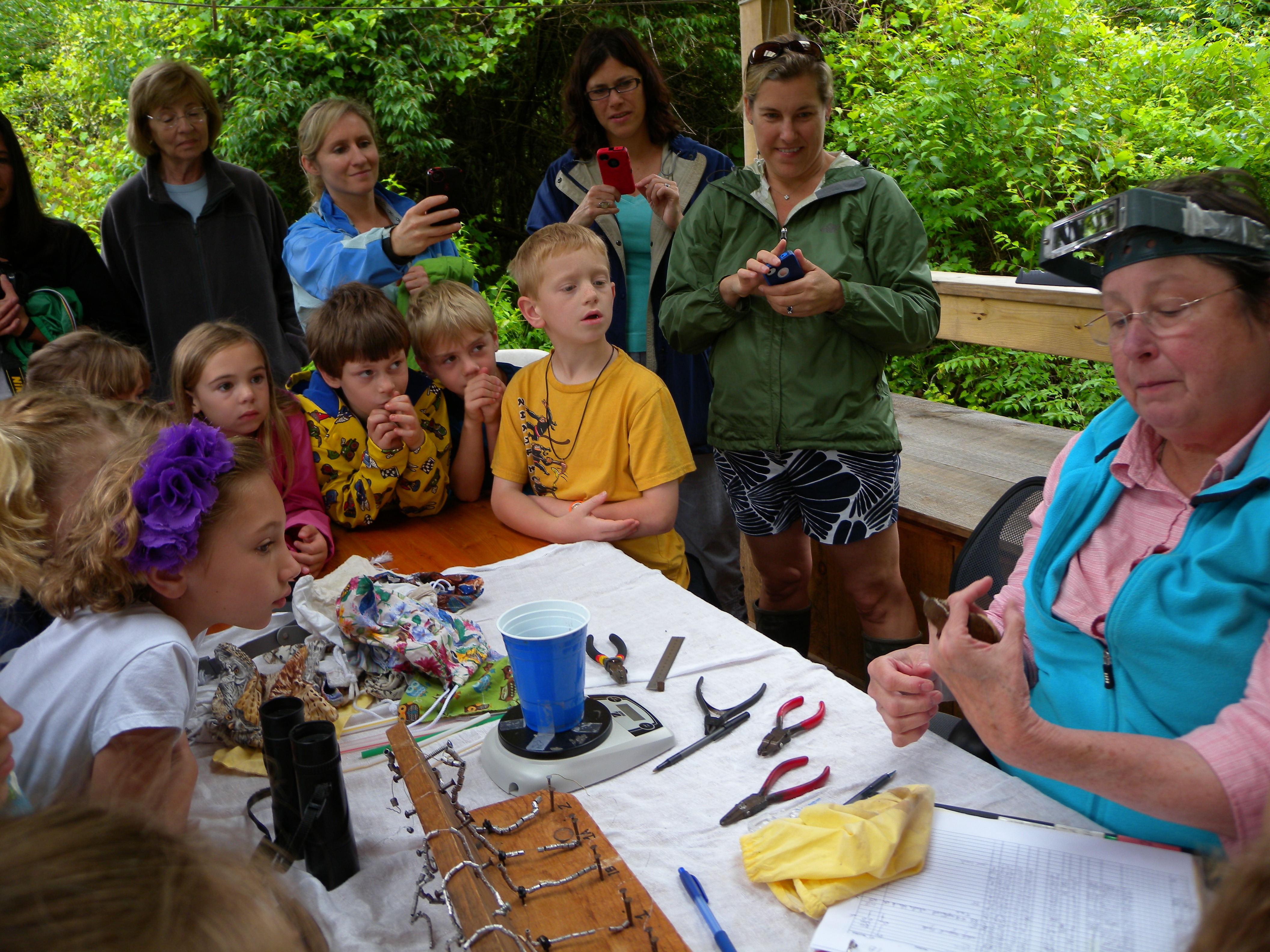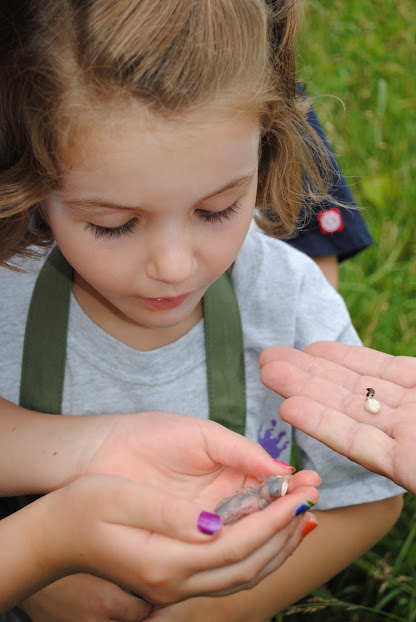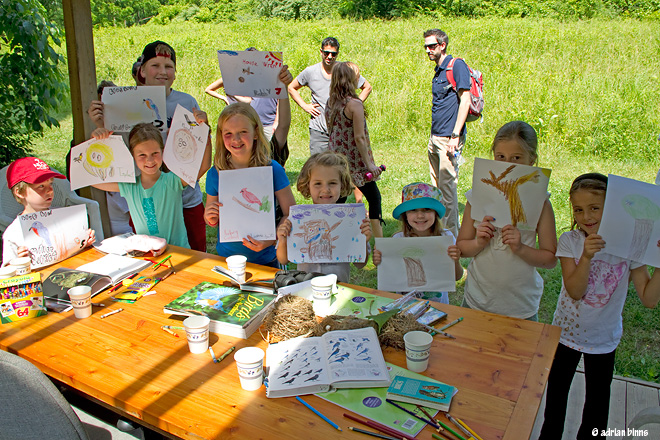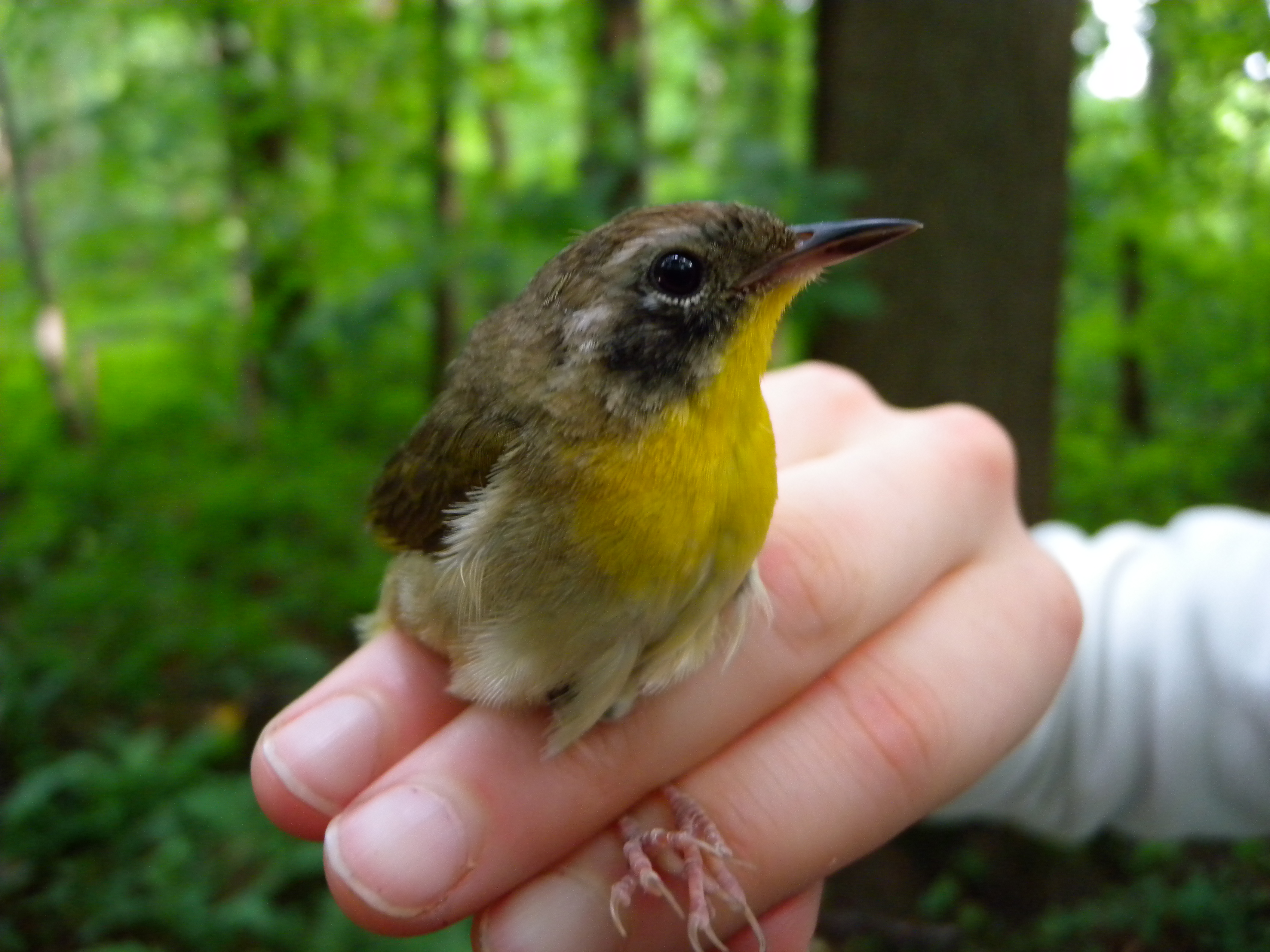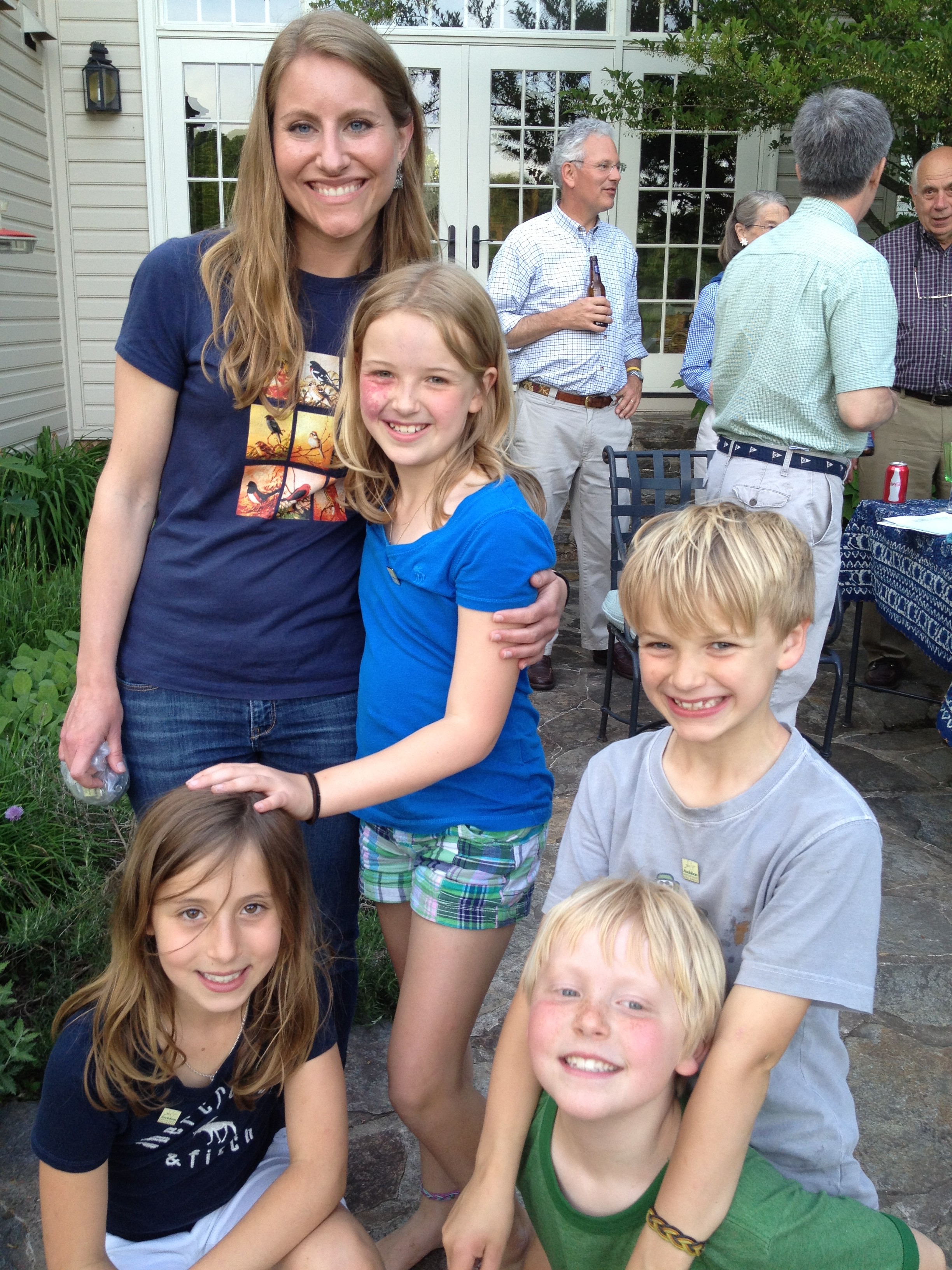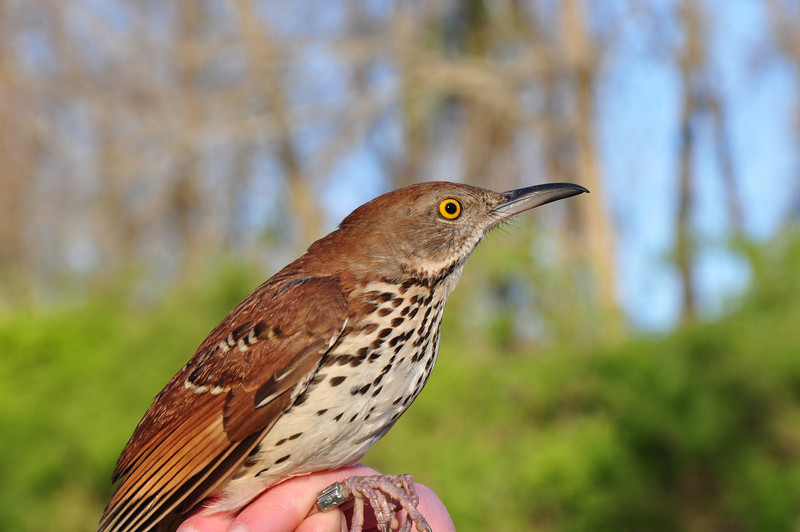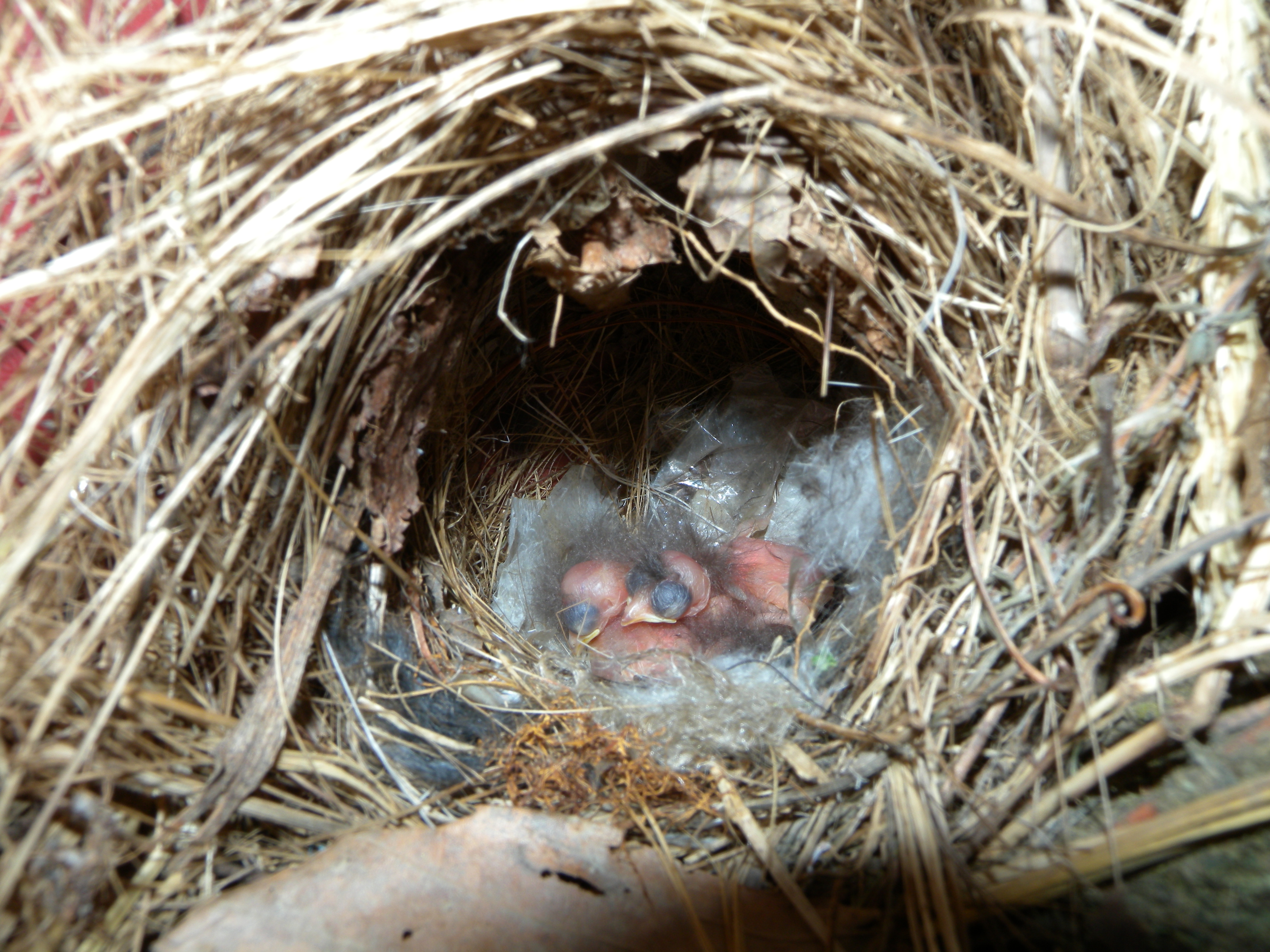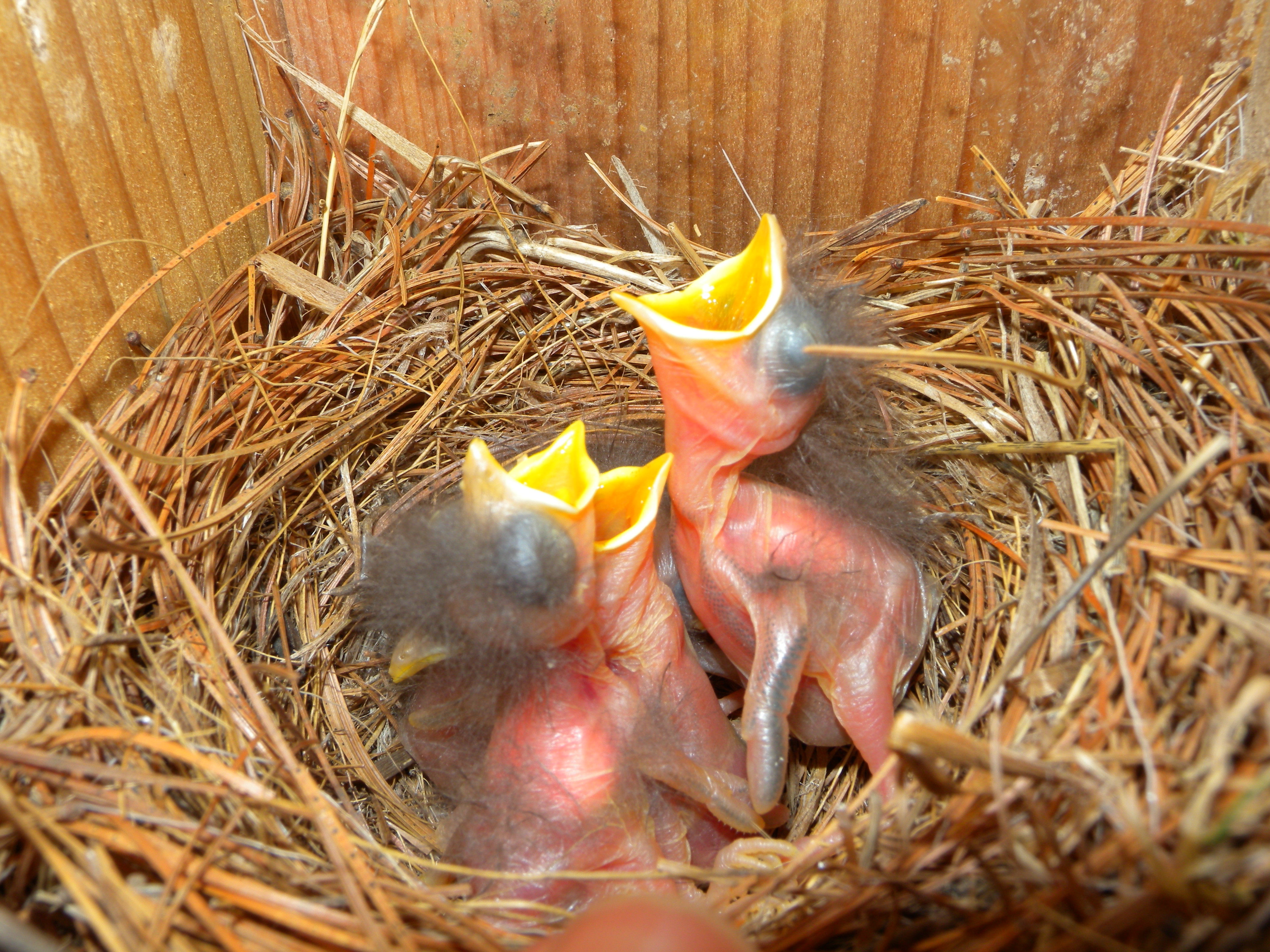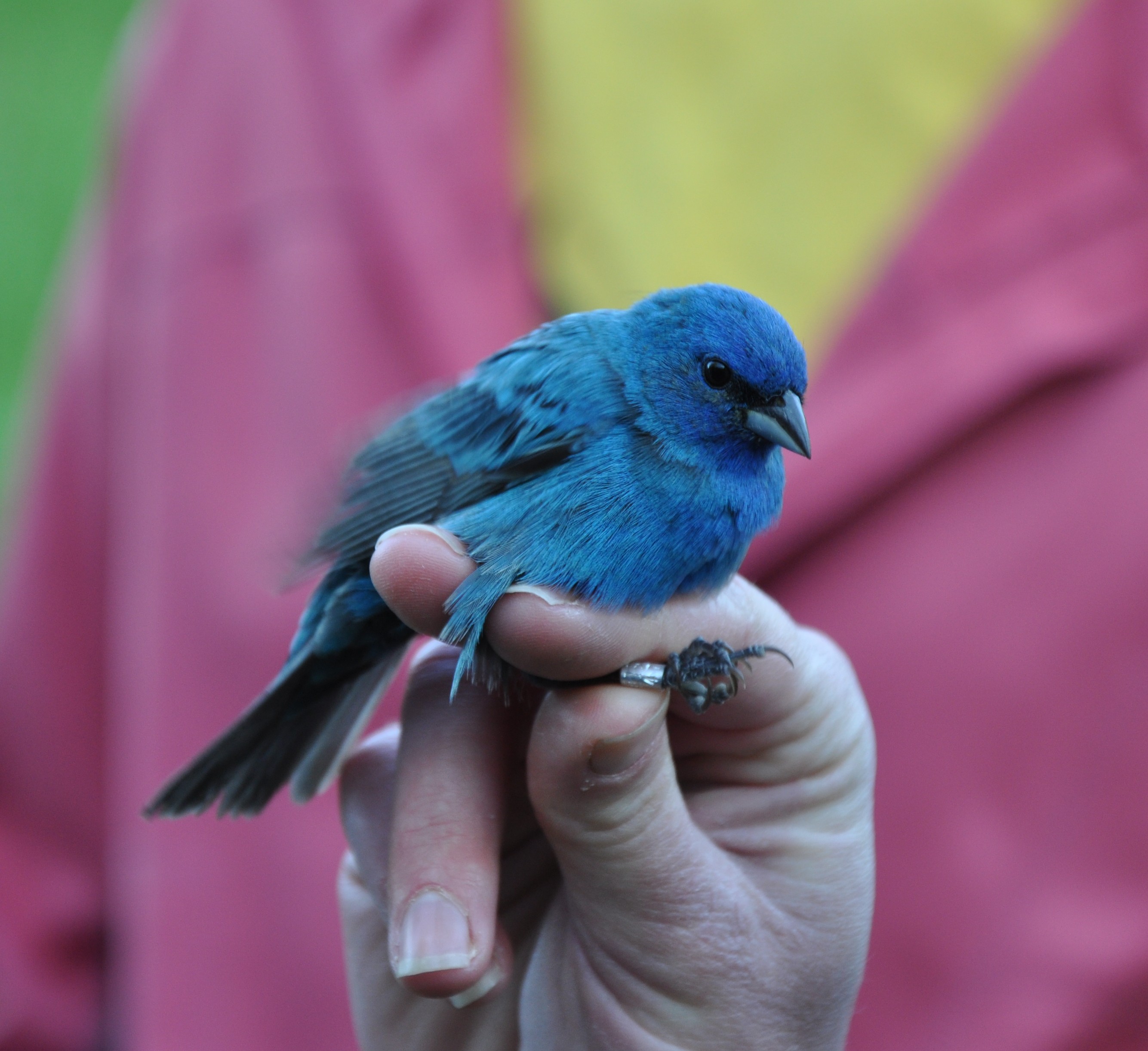
Nesting season is over, and fall migration is very near. We must soon say goodbye to migratory beauties, like the Indigo Bunting. In fact, I have already noticed that the Gray Catbirds seem to have all but disappeared from my yard. Their melodious songs and not so melodious cat-like calls are regrettably absent from the sparse late summer chorus of my backyard these days.

However, I did glimpse a shy young catbird in the woods privately stuffing his face full of Black Gum berries a few days ago. The tree has surprisingly already begun its foliar fruit flagging; its glossy, scarlet purple leaves alert the hungry migrating songbirds to a secret berry feast that might otherwise go undetected and thus wasted. It’s amazing how all the parts of nature communicate so effectively with one another, as if the trees themselves speak a language we can neither hear nor understand.
Click here to visit the website of Marcia Bonta, prominent naturalist writer, to learn more about the imminent color of Autumn leaves and the migrant birds that depend on them. Fascinating.

Shorebird fall migration has been underway for a couple weeks now. In fact, three new species have been added to our “Species Seen in 2012” list including the Semipalmated Sandpiper, Lesser Yellowlegs and Least Sandpiper. These birds, which are only seen in this area during migration, were all sighted at the mudflats at Springton Reservoir, a great place for “neighborhood shorebirding”. This brings our total bird species seen in the Willistown area to 157! Keep sending in those sightings so we can hit our goal of 165 bird species by the end of the year!

If you are planning on setting out on a shorebird birding adventure, keep in mind that the best flight days are days with WNW winds after a cold front. As with songbirds, the juvenile shorebirds are not on the move yet. After all, kids will be kids fooling around and lagging behind the adults. Perhaps on your shorebird adventure to, say, the Delaware Bay, you might be lucky enough to spot B95, the most amazing athlete in the world (the Olympic athletes have nothing on this bird!)
B95 is a 20 year old, 4-ounce Red Knot who, thanks to banding, was discovered to still be alive and healthy this spring after traveling a staggering distance equivalent to the moon and halfway back over his lifetime. Check out this Philadelphia Inquirer article to learn more about the amazing “Moonbird” and the new book about him, by Phillip Hoose, geared towards youth but fascinating for adults too.
Also swiftly coming down the pike are the migratory raptors. The Hawk Mountain hawk watch begins Wednesday and they have already reported a few migrants trickling in including Bald Eagle, Merlin, American Kestrel, Broad Winged Hawk and Sharp-shinned Hawks. Keep track of the migration by visiting their Raptor Count page. If you are planning a visit to Hawk Mountain this fall, be sure to check out their events calender as they have all kinds of great events, lectures and festivals going on, like Bald Eagle Migration Day August 25.

Looking Ahead to Rushton Fall Banding
Fall songbird migration banding at Rushton will begin after Labor Day. The exact date is yet to be determined, so stay tuned! The banding station will be open to the public on Tuesdays and Thursdays from sunrise until 11am, through the first weeks of November. Northern Saw-whet Owl banding will begin in October.

Individuals and small groups never need a reservation for songbird banding in the morning. Large groups should contact Lisa Kiziuk (lkr@wctrust.org) to make a reservation. School teachers who would like to bring their classes to songbird banding should contact Blake Goll (bhg@wctrust.org). These field trips can be catered to the needs of the class, but typically run from 9am –noon and include the three-station grand tour of our beautiful “outdoor classroom.” The hands-on educational tour includes a study of the small scale-high yield, sustainable CSA farm, a woodland ecology walk, and observation of the science of bird banding.

Anyone looking to bring a group to Saw-whet Owl banding this Fall should contact Lisa Kiziuk (lkr@wctrust.org) ASAP, as nights are quickly getting booked!
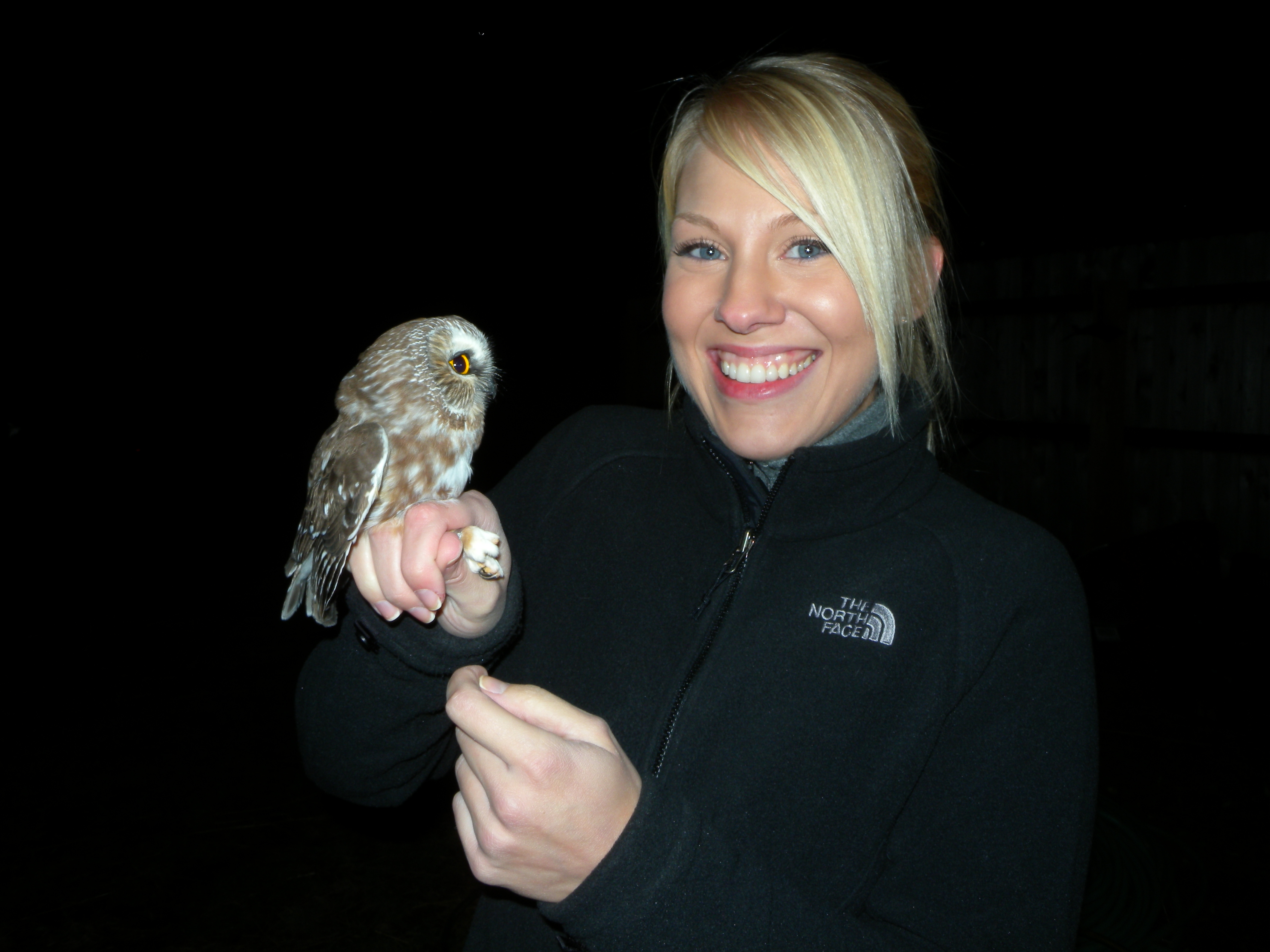
NOTE: To help support our growing number of quality education programs, please understand there may be a nominal fee associated with Rushton field trips and Saw-whet Owl banding.
PA Young Birders
Last month’s PAYB Poetry Workshop was exceptional, thanks to Cathy Staples (award winning poet and Villanova poetry professor) and her lovely assistant and daughter, Natalie Staples. The young birders explored the community garden for sensory details to use in their poems.


They were so inspired and focused that they did not seem to care much about the sweltering heat and humidity! With Cathy and Natalie’s patient guidance, the children produced profound poems about the butterflies, birds, vegetables, flowers, and scenery they had observed. Here are some of their masterpieces (If you click on them, they should open in another window and be easier to read):
One of the parents was even inspired to write a poem about the ferocious storm that cut our meeting short. Before we were able to illustrate our poems, the sudden vehement wind and ominous rumbling clouds sent the parents and Young Birders frantically fleeing to their cars for safety as unused paint brushes and watercolor paper were sent whirling from the table….
Storm Coming
HUGE, billowing, deep, dark clouds covered the sky as we crossed Haverford Road.
Streetlights shone in the black, as if it were night.
Winds whipped branches and drove dust across our path.
The car hurtled faster, racing to beat the clouds home.
Would we make it?
Thunder rumbled its low throaty growl, seemingly distant, yet threatening so near.
Where was the lightning? Where was the rain?
A rolling stop, a quick turn,
Accelerate, turn, faster.
Oh no, slow for the speed bump!
Accelerate, brake, another bump!
Here comes the wind raising a wake across the pond.
Wish the walker luck . . . she’ll soon be wet.
The last turn, pedal down, darn last bump.
Screeching into the carport, hop out and run for the door.
We made it!
By Sheryl Johnson

The next PAYB meeting, “Farm, Birds and Bugs,” is this Wednesday August 15 at Rushton Woods Preserve and Farm from 6-7:30pm. This month’s meeting will feature guest speaker, John Black, a Master Naturalist for Edwin B. Forsythe National Wildlife Refuge in New Jersey. He is also on the Board of Directors for the Atlantic Audubon Society and describes himself as a long-haired, tree-hugging, dirt worshiping environmentalist! He will be sharing with us his vast knowledge about the natural world, especially native plants, spiders and insects, with an emphasis on the Monarch Butterfly. We will discover these insects and birds of Rushton and learn how the sustainability of the farm brings people, animals and plants together in harmony.
Please RSVP to Blake Goll (bhg@wctrust.org).
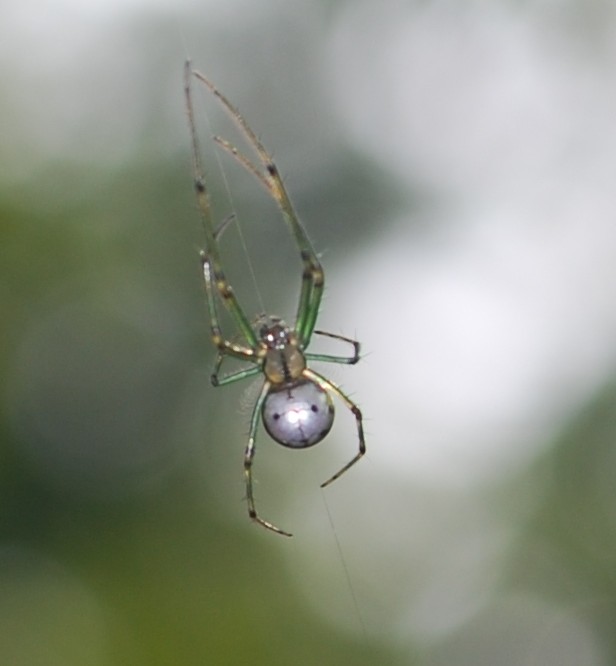

We would also like to encourage all PA Young Birders to attend the upcoming ABA Mid-Atlantic Young Birder Conference on September 22, 2012 from 9:00 to 4:00 (optional pre-conference birdwalk begins at 8:00) at the Ashland Nature Center, Hockessin, DE. “Bird walks and hawk watching at the peak of fall migration will feature prominently, as will concurrent indoor learning sessions for new and experienced young birders alike, allowing everyone from elementary school through late teens to find things of interest. There will also be special sessions by and for parents, mentors, and club coordinators.”
For more information about this exciting conference, please visit the website.
Our Last MAPS Mornings
“Summer MAPS (Monitoring Avian Productivity and Survivorship) banding for this year has come to a close. Our feet have grown accustomed to the rhythm of making a figure eight around the woods for each net check. We will certainly miss gathering in the heart of the Rushton woods, listening to the solid tree trunks sound again, and walking across the stream to examine Net Seven in the hopes of another Kentucky Warbler,” sighed Natalie Staples.

During the two final MAPS mornings we did not have as many birds, but there were some notable visitors! One of which was our first Red-eyed Vireo, a breeding adult female judging by her brood patch. A brood patch is basically a bare belly that results after the female plucks out all her belly feathers in order to better regulate the temperature of her eggs.

We hope this female vireo was only brooding her own young, but often these birds become unknowing hosts to the lazy Brown-headed Cowbird, a nest parasite who deposits her eggs in someone else’s nest to tend to rather than making her own nest. The world may never know since our Red-eyed Vireo’s nest of twigs, bark strips, grasses, pine needles, and lichen was held together with spider web high up in the canopy of Rushton Woods where no one would ever lay eyes upon it.

The final MAPS banding sessions were full of very cute babies, technically called juveniles, of many species including:
- Common Yellowthroat
- Gray Catbird
- Wood Thrush
- Veery
- Northern Flicker
- Tufted Titmouse
- Carolina Chickadee
- Eastern Towhee
- American Robin
- Carolina Wren
- Downy Woodpecker
- Northern Cardinal
- Ovenbird

Our top two most common babies were the Gray Catbird and Wood Thrush. This is great because the Wood Thrush is a state responsibility species, meaning that Pennsylvania hosts a substantial percentage, about 8.5%, of the world’s breeding population of wood thrushes. We can confidently say that Rushton is carrying its weight in the state’s stewardship of this ethereal and declining interior woodland nesting bird. Read July’s e-bird news for more excellent information on the Wood Thrush, “The Symbol of Declining Forest Songbirds”.
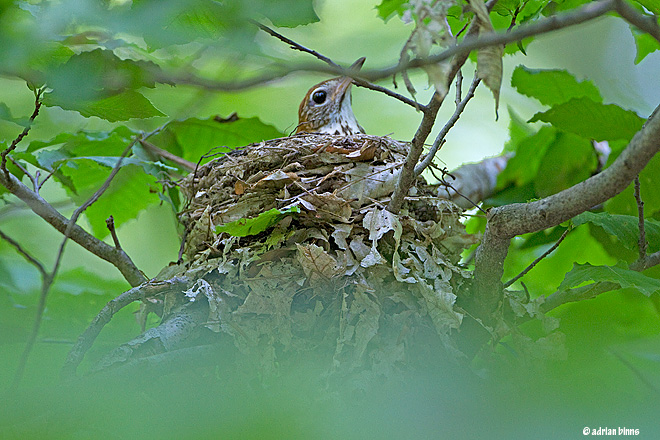
The two biggest highlights of the summer were the Wood Thrush nesting right above our banding table in the woods (what a joy to share your work space with such a normally secretive bird and her growing family) and the famed Kentucky Warbler. He was so handsome and rare to behold that once in the hand, it had the same googly-eyed, mouth-watering effect on the banders as a king size butterfinger has on a trick-or-treating kid on Halloween night! Of course, instead of eating this bird we banded it and noted that it was a breeding male by the size of his cloacal protuberance.
Unfortunately, this young male could have merely been intending to breed but never found a female. We heard him singing and claiming territory and saw his protuberance first-hand but still cannot confidently say that we have breeding Kentucky Warblers in Rushton Woods. This is an improvement from last year though, when we only faintly heard one ‘KEWA’ singing at one point. If we continue on this upward trend, maybe next year we will band a female with a brood patch and the year after that, a juvenile Kentucky Warbler, the best evidence of all that the understory of Rushton is healthy enough to support this skulking understory nester.

As for our MAPS totals in comparison to last summer, we banded 103 new birds and had 72 recaptures this year. Last year, our numbers were higher with 157 new birds and 87 recaptures. We cannot say whether this is significant or try to find trends at this point. “I would say that we completed another successful MAPS season with the highlight of KEWA (Kentucky Warbler). Multiple data points are needed to describe trends, and we won’t have that for at least two more years. We were disappointed by the number of birds caught this year, but we understand populations vary from year to year,” explained Doris McGovern, our federally licensed bird bander.
Now as for the cutest baby bird award of this summer, it’s a toss-up! According to Natalie, it was the Carolina Chickadee. “He was quite adorable and came just in time for the Westtown students to witness his arrival! Chickadees are a fascinating species that challenge the expression, bird brain. According to the Cornell Lab of Ornithology, Black-capped Chickadees, which the Carolina Chickadee will breed with, allow brain neurons containing old information to die and replace them with new neurons. This act allows them to adapt to their changing environments and seasonal demands, despite the size of their brains,” Natalie found. Upon further research, she was delighted to find out that, “although female Carolina chickadees will hiss if their nest is disturbed, in general chickadees are easily tamed and can be hand fed!” I wonder what Natalie will be doing with her spare time now…Training chickadees?

Natalie also really appreciated the Ovenbird’s cute factor. “One of the most exciting moments in our last morning was when a baby Oven Bird flew into one of our nets!” , she exclaimed. Oven birds are so called because of their nest that looks like a Dutch oven. They are ground nesters and are often found hopping on the ground. “I am always struck by the distinctive dark speckles on the underside of the Oven Bird,” Natalie notes.
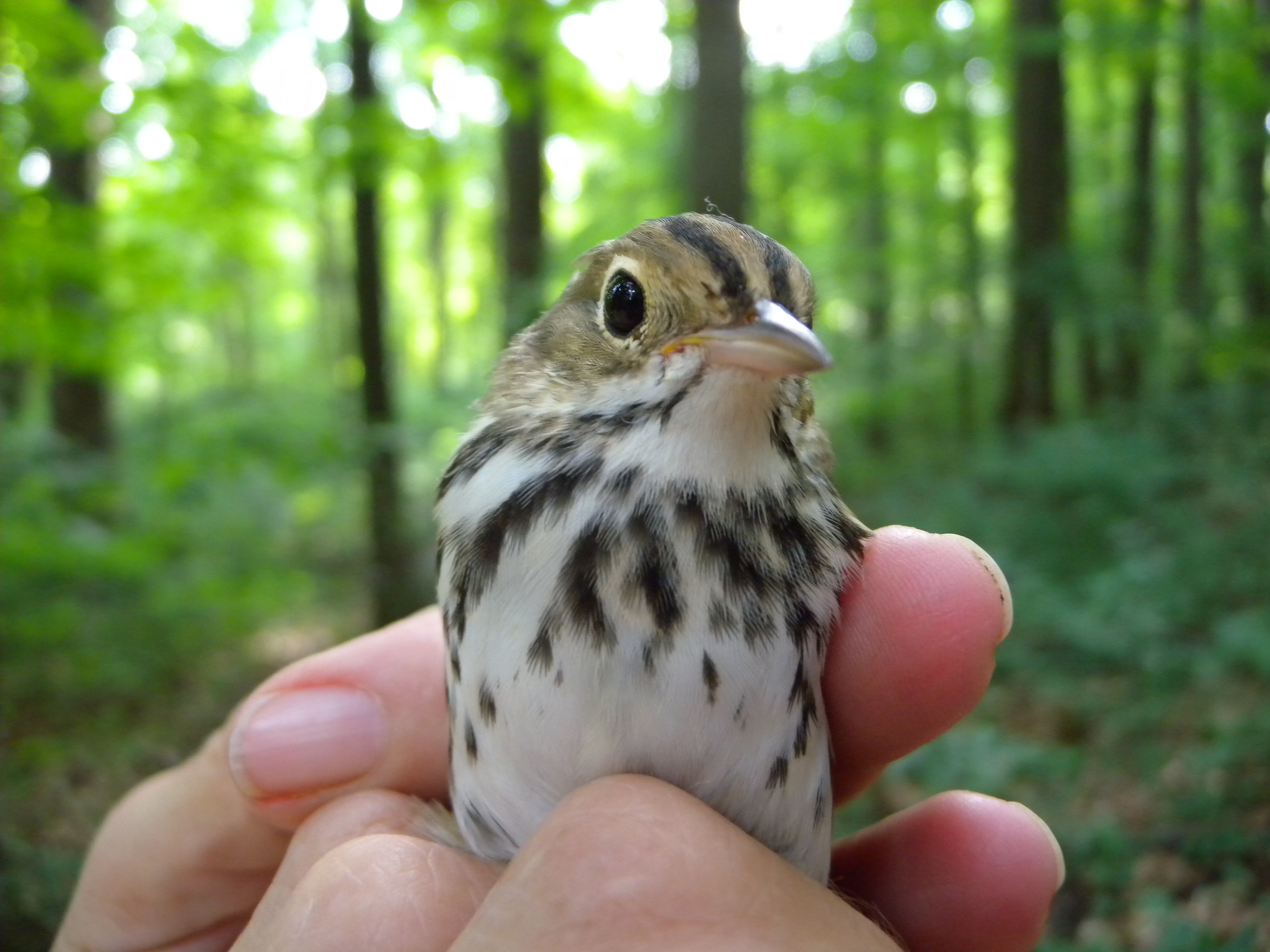
In his meditative poem, “The Oven Bird”, Robert Frost draws our attention to the bird’s memorable song. The sonnet turns as Frost links seasonal changes with the life cycle and asks, “What to make of a diminished thing”.
The Oven Bird
by Robert Frost
There is a singer everyone has heard,
Loud, a mid-summer and a mid-wood bird,
Who makes the solid tree trunks sound again.
He says that leaves are old and that for flowers
Mid-summer is to spring as one to ten.
He says the early petal-fall is past
When pear and cherry bloom went down in showers
On sunny days a moment overcast;
And comes that other fall we name the fall.
He says the highway dust is over all.
The bird would cease and be as other birds
But that he knows in singing not to sing.
The question that he frames in all but words
Is what to make of a diminished thing.
Click here to read an enlightening All About Birds article from Cornell that echoes Robert Frost’s sense of loss over the lively spring bird chorus and highlights the reasons behind the irony of birds actually being more abundant this time of year than in spring, even though the woods seem so quiet now.

The Ovenbirds might be enchanting and their babies cute, but the baby that won my heart this summer was the plain Tufted Titmouse. There was something so endearing about the little tufts of feathers sticking out from his head in random places and his little bill that seemed like somebody shrunk it!

Which baby bird from this summer is your favorite?
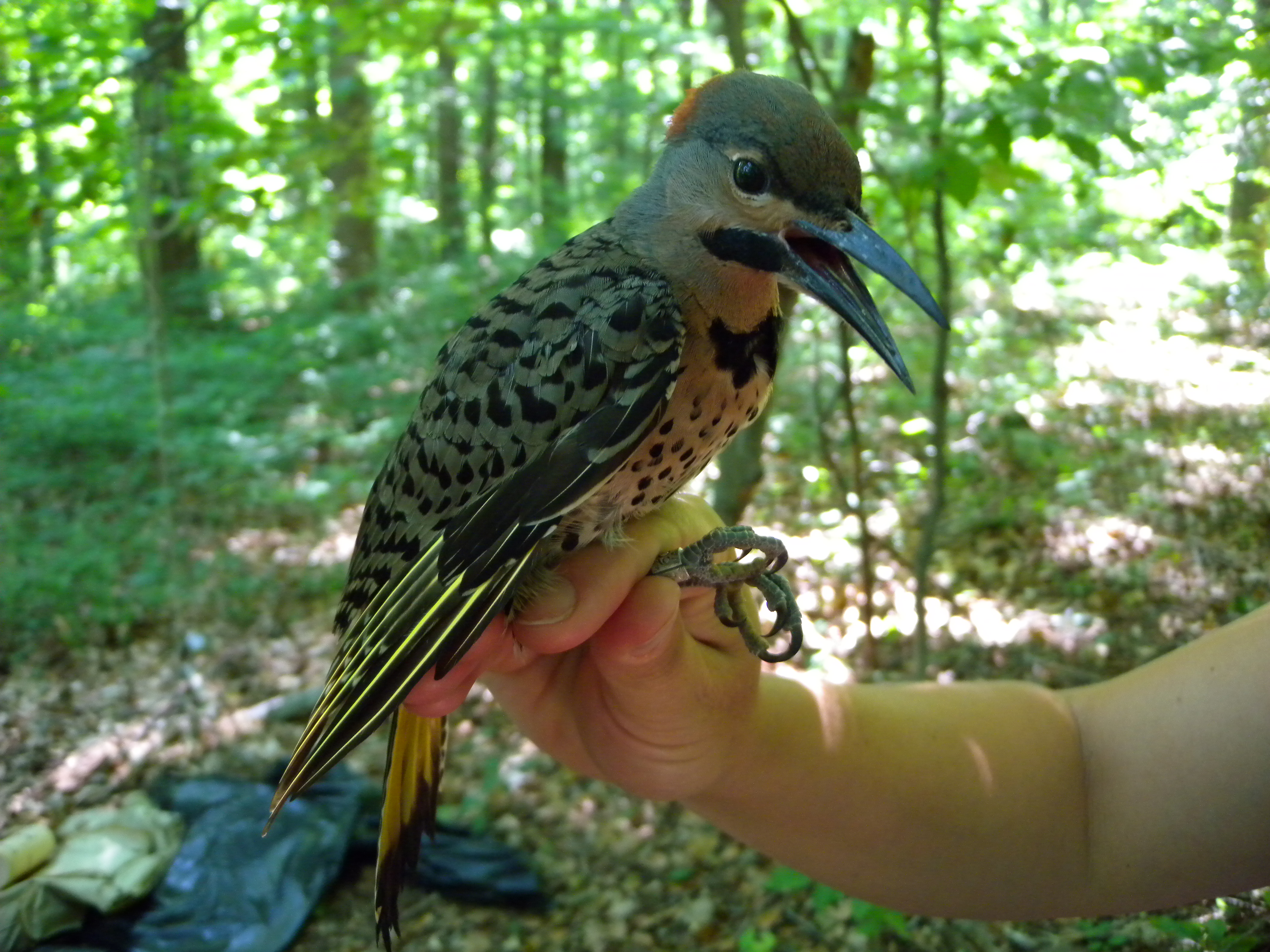
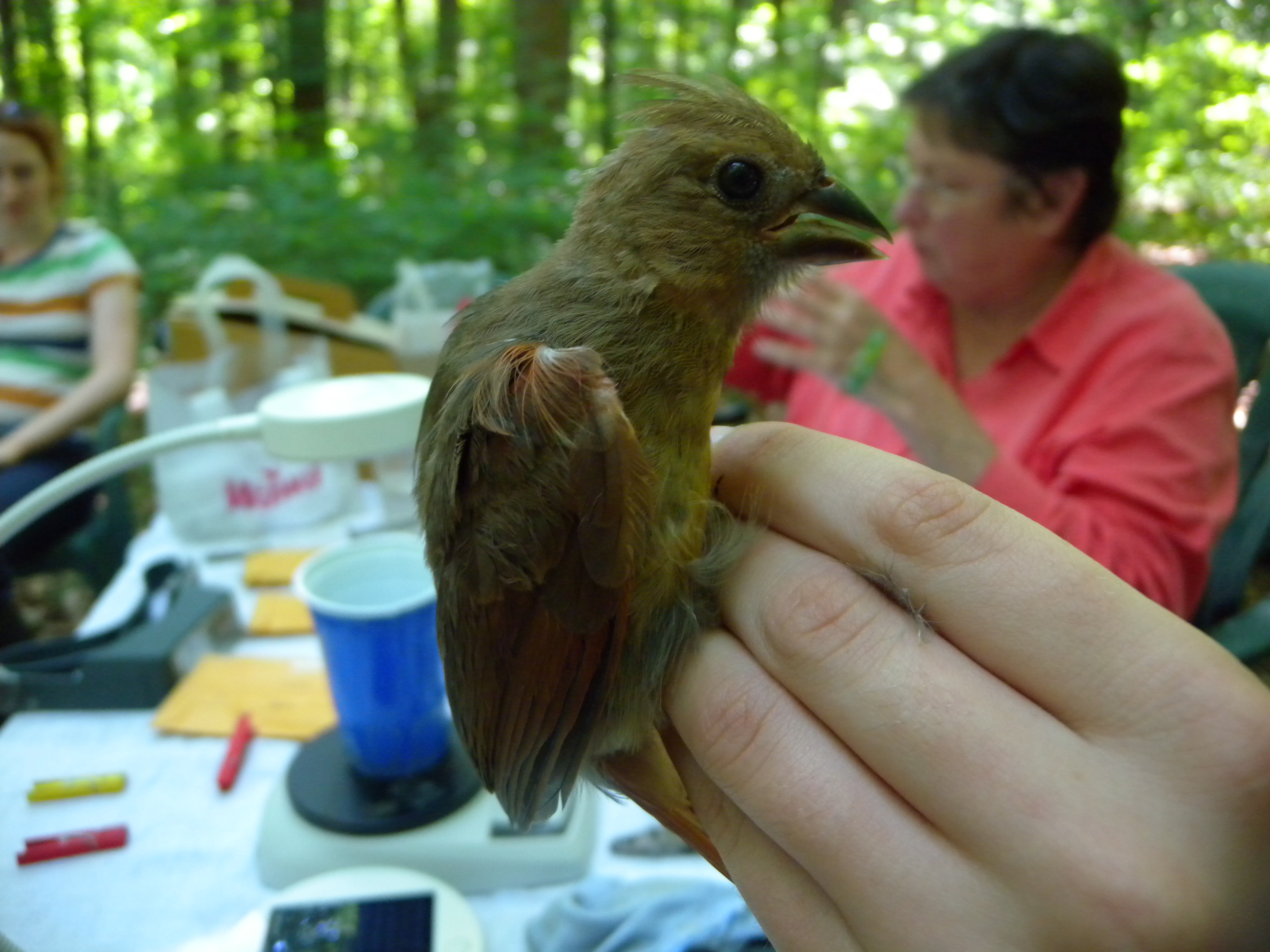


Remember from a previous blog post that although it’s fun holding young birds in the hand, MAPS is rigorous science and the best thing a banding station can do for bird conservation. We do this because our data, in addition to data from about 500 MAPS stations sprinkled across the U.S., is crucial to understanding changes in bird populations. Banding birds creates individuals, which allows us to understand whole populations and see trends. Keeping track of these bird populations is the only way to detect significant declines and to ultimately guide land management decisions to the benefit of birds using sound scientific data. When we band young birds, we take care to walk them back to where they were caught to release them in the vicinity of their parents’ care.
Late Summer Nesters
Recently, the Rushton farm staff discovered a bird’s nest on the ground by the greenhouse. Looking at the eggs, we decided it is most likely a Carolina Wren’s nest. The dark rust-colored speckles, a characteristic of Carolina Wrens’ eggs, are particularly striking. A pair of Carolina Wrens will often build several nests together before deciding upon one. It’s a joint effort with one wren staying by the nest while the other forages for materials. Nests around homes have been reported to be found in boots, mailboxes and old coat pockets! The nest we found could very well be this pair’s third brood of the season.

While harvesting last week, the farm staff were surprised to find another late nest among the Striped German tomatoes. They believe it is the nest of a Song Sparrow. It is very well hidden in one of the thicker patches of tomato vines. These nests are exciting, tangible examples of the success of the mutually beneficial relationship between sustainable agriculture and the local bird population.

For Fun
- Participate in GO WILMA (Get Outside Willistown and Malvern), a local outdoor adventure/summer reading program for K-5th graders and their families. Children receive Captain’s Logs from Malvern or Paoli libraries and then use the clues to search for stars hidden in special places this summer, including our own Rushton and Kirkwood Preserves. Go to willistownparks.org to find out more and take advantage of this fun program before it ends August 24th!
- Read “Cerulean Blues: A Personal Search for a Vanishing Songbird” by Katie Fallon. This is a new book on birders’ radars that wonderfully documents the 2000 mile journey of the elusive Cerulean warbler, the fastest declining warbler species in the U.S., from Appalachia to a coffee plantation in Colombia.
- Check out Thomas Poulsom’s quest to have LEGO bird kits available for sale, and support the idea with your vote! Click here to read an article about it. There you will find links to Tom’s flickr page where you can browse all of his LEGO creations. They are amazing and quite elegant and feature birds in their specific habitats, allowing kids to learn about birds as they build. It’s enough to turn even adult birders into “LEGO maniacs”!
Enjoy the waning days of summer and look forward to the warblers to come,
~Blake Goll (and Natalie Staples)
I leave you with the poem expertly selected by Cathy and Natalie Staples as inspiration for our Young Birders during the poetry workshop:



















